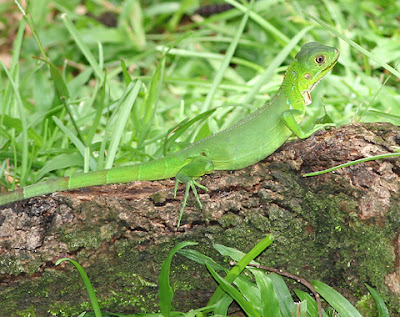Green Iguana | The Green iguana is undoubtedly one of the most popular pet reptile world. Green iguana or Common iguana is a large tree herbivorous lizards of the genus Iguana. Green iguanas come from the rainforests of northern Mexico to southeastern Brazil, where temperatures and humidity are high. Green iguanas inhabit
most tropical forests near water, although they avoid areas of the deep
woods where the sun can not reach the ground to the nest to breed.
Often found in captivity as pets because of his quiet nature and the
bright colors, the demanding to ensure well. Space requirements and the
need for special lighting and heat can prove challenging to an amateur
hobbyist.
Scientific classification
Kingdom: Animalia
Phylum: Chordata
Class: Reptillia
Order: Squamata
Family: Iguanidae
Genus: Iguana
Species: I. iguana
Class: Reptillia
Order: Squamata
Family: Iguanidae
Genus: Iguana
Species: I. iguana
Despite their name, Green iguanas
come in different colors. They can appear bluish in color with bold
black markings. They can range from green to lavender, black, red and
even pink. Can the young bright blue as baby. Green iguana
possess a row of spines along their backs and along the tail which
helps to protect them from predators. Their whip-like tails can be used
to deliver painful strikes and like many other lizards, when grabbed by
the tail, the Green iguana can allow to break, so it can escape and possibly regenerate a new one. Green iguanas
have a excellent vision, allowing them to detect shapes and motions at
long distances. They can detect movement of the sensitivity to changes
in light and dark. This helps the Green iguana when being stalked by predators from above.
Green iguanas
have very sharp teeth capable of shredding leaves and even human skin.
These teeth are shaped like a leaf, broad and flat, with teeth on edge.
The similarity of these teeth with those of one of the first dinosaurs
discovered led to the dinosaur was named Iguanodon, meaning "iguana
tooth", and the mistaken assumption that it had looked like a giant
iguana. The teeth are located inside the jawbone which is why they are
difficult to see in smaller specimens. The Green iguana
is either flaky skin is evenly colored, or bears blackish brown stripes
and a contrasting pattern. Prominent large, round scales are present on
the lower jaw in the clearly visible eardrum. Male Green iguanas
could be distinguished from females by the more pronounced spiny crest
and large head, the more noticeable femoral pores, and the wider cloacal
opening.
When frightened by a predator, Green iguanas will attempt to flee, and if near a body of water, they dive in and swim away. If cornered by a threat, the Green iguana
to expand and give the skin under the throat, neck, stiffen and puff on
his body, noise, and Bob his head on the aggressor. If the threat
continues iguana may whip its tail, bite and use its claws in defense.
The wounded are more inclined to fight than uninjured prey. Green iguanas being attacked by hawks and their fear of hawks is exploited as a trick to catch them in the wild. Green iguanas
are primarily herbivores, feeding on leaves, flowers, fruits, and
shoots growing from over 100 different types plant. Although they will
have a wide variety of foods to consume if offered, Green iguana are naturally herbivores and require a precise ratio of minerals in their diet. Juvenile Green iguana
often eat feces from adults to acquire the essential microflora to
their low quality and difficult to digest vegetarian diet alone process.
Throughout Latin America, the Green iguana
is hunted for its beautiful, commercially valuable skin, meat and eggs
valued. It is one of the neotropical reptiles most hunted for food,
feeding the family or for sale, and is slain by guns or captured by
dogs. They will also be live-trapped, newly hatched iguanas can be
exported for the pet trade, while the females captured can be cut open
to retrieve the eggs and then released. The Moche people of ancient Peru
worshiped animals and often depicted Green iguanas
in their art. The Green Iguana and the relative the Black iguana were
used as a food source in Central and South America in the past 7000
years. It is possible that a proportion of the population in the
Caribbean were translocated from the mainland by various tribes as a
food source. In Central and South America, Green iguanas
are still used as a source of meat and are often referred to as the
Gallina palo, "bamboo chicken" or "chicken of the tree," because they
are reportedly tastes like chicken.






No comments:
Post a Comment